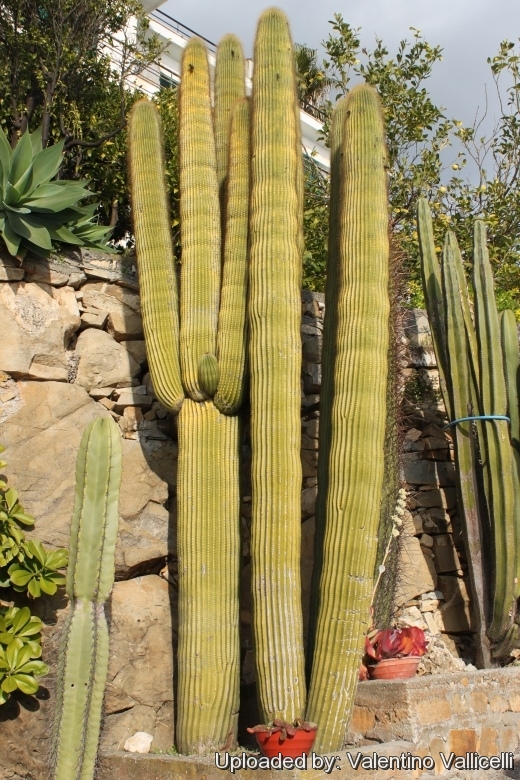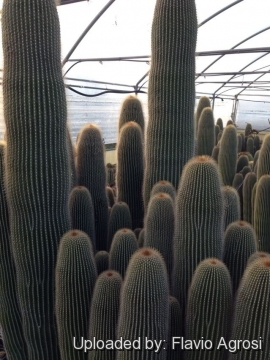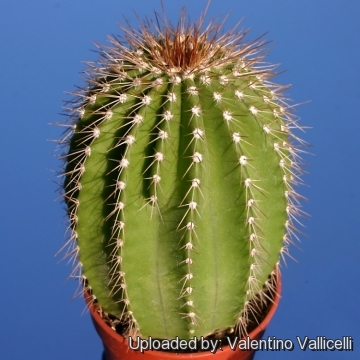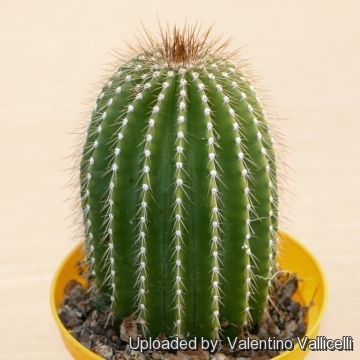Accepted Scientific Name: Neobuxbaumia polylopha (DC.) Backeb.
Blätt. Kakteenf. 1938, No. 6, p. [24].

Cephalocereus polylophus (Neobuxbaumia polylopha) Photo by: Valentino Vallicelli
Origin and Habitat: Neobuxbaumia polylophaSN|6399]]SN|6399]] is endemic to a small area in the state of Guanajuato, Hidalgo, Querétaro and San Luis Potosí. Mexico (extent of occurrence less than 6 km2). It is found within less than 10 locations.
Altitude: 800-1300 metres above sea level.
Habitat: This species grows primarily in limestone canyon wall, where it emerge majestically from the thorny deciduous forest, in this area there are several columnar species and other cacti like Mammillaria priessnitziiSN|9445]]SN|9445]] and Ferocactus glaucescensSN|1532]]SN|1532]]. It is naturally rare and dispersed, and they are in decline due to the development of canyon areas for tourism and other developments. There is also a bacteria effecting many subpopulations.
Synonyms:
See all synonyms of Neobuxbaumia polylopha
Common Names include:
ENGLISH: Cone Cactus, Wax Cactus, Golden-Spined Saguaro, Golden Saguaro
SPANISH (Español): Cardón.
Description: Very tall columnar cactus with a thick telephone pole-like stem , 7-12(-15) m tall; Often remain solitary but it can ramify forming a candelabra-like tree with little curved branches. This plant is characterized by the many, narrow, closely spaced ribs
Stem: Thick, columnar, deeply ribbed, green.
Ribs: 10-30 narrow, acute.
Areoles: Small, 4-6 mm apart with yellowish felt.
Spines: Yellowish turning grey as they age, thin, acicular, bristle-like, mostly pointing downward, approx 1 to 2 cm long. As ages, spines tend to fall out.
Central spines: 1.
Radial spines: 4-8.
Flowers: Diurnal, externally green with vivid pink, dark red or magenta (or orage-yellow) petals near the top of the cactus, their ovary is sometimes tuberculate, with small scales and red filaments.
Fruits: Small, cylindrical, greenish approx 4 cm long. They mature rapidly and the seeds can be ready to germinate in only 3 weeks. They open in a quite peculiar way and form something like a star on the stem of the plant with the black seeds in contrast with the off-white colour of the pulp. The fruits are totally exposed to the birds that devour them quickly. They are also edible for humans, tastes smoothly sweet and remembers a very mature plum.
Bibliography: Major references and further lectures
1) Gómez-Hinostrosa, C., Sánchez , E., Guadalupe Martínez, J. & Bárcenas Luna, R. 2013. Neobuxbaumia polylopha. In: IUCN 2013. "IUCN Red List of Threatened Species". Version 2013.2. <www.iucnredlist.org>. Downloaded on 17 March 2014.
2) James Cullen, Sabina G. Knees, H. Suzanne Cubey “The European Garden Flora Flowering Plants: A Manual for the Identification of Plants Cultivated in Europe, Both Out-of-Doors and Under Glass” Cambridge University Press, 11/Aug./2011
3) David Hunt, Nigel Taylor “The New Cactus Lexicon” DH Books, 2006
4) Edward F. Anderson “The Cactus Family” Timber Press, 2001
 Cephalocereus polylophus (Neobuxbaumia polylopha) Photo by: Flavio Agrosi
Cephalocereus polylophus (Neobuxbaumia polylopha) Photo by: Flavio Agrosi Cephalocereus polylophus (Neobuxbaumia polylopha) Photo by: Valentino Vallicelli
Cephalocereus polylophus (Neobuxbaumia polylopha) Photo by: Valentino Vallicelli Cephalocereus polylophus (Neobuxbaumia polylopha) Photo by: Valentino Vallicelli
Cephalocereus polylophus (Neobuxbaumia polylopha) Photo by: Valentino Vallicelli Cephalocereus polylophus (Neobuxbaumia polylopha) Photo by: Valentino Vallicelli
Cephalocereus polylophus (Neobuxbaumia polylopha) Photo by: Valentino VallicelliCultivation and Propagation: Neobuxbaumia are of easy culture and can grow 15-20 cm a year. They are cold intolerant. Make sure they are not exposed to freezing temperatures ( Hardy to -2°C) or they may die. They need a well drained soil mix. It appreciates abundant water during the summer and, during its growing period but allow to dry fully before watering again, it is possible to add a fertilizer 6-6-18 from time to time. During the winter months they should be rather kept dry. Since they are rapid growers, they need plenty of space for their roots. Repotting should be done every other year, or when the plant has outgrown its pot. Sun Exposure: Light shade when young, full sun later. In mild climate they can be grown in rock gardens in full sun, in dry and sandy soils.
Propagation: Usually by Seeds (Seeds should be sown in a well-drained soil mix. Surface sowing is the best; seeds germinate in 14-28 days at 25° C, or from cuttings in spring (let them dry till the ends callous well). Then replant them in fresh cactus soil that is ever so slightly moist, and keep it that way till they root)














